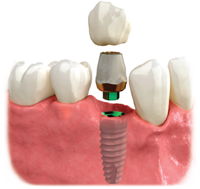Are Dental Implants for Me?
Often I am asked by patients if they are a good candidate for dental implants.
I always answer yes, but then I continue with two questions: “Why do you ask?” and “What is it you really want?”
You see, most people don’t really want implants; they want teeth! Dental implants are just a means to help them get their missing teeth replaced.
If you are missing several teeth and don’t mind the look of missing teeth and eating mush for dinner, perhaps dental implants aren’t for you. But, if you are missing anywhere from one tooth to all the teeth in your mouth, dental implants are a wonderful way to get those missing teeth replaced.
In the past, the only means dentists had to help replace missing teeth were either to provide a removable denture (replacing some or all the missing teeth) or to place a fixed bridge on the existing teeth. And while these treatment options were great alternatives to missing teeth, they have many limitations.
Partial dentures use the remaining teeth to help hold the denture in place with the use of clasps on these remaining teeth. Over the years, these clasps place heavy stresses on the remaining teeth and can ultimately cause the loss of the remaining teeth, leading to even more tooth loss. This is indeed the slippery slope where the more teeth missing the fewer teeth remain to sustain the stresses of retaining the denture, and the faster these remaining teeth succumb to the stresses and are lost.
This ongoing loss of the remaining teeth may eventually lead to complete loss of all the teeth, or what we dentists call complete edentulism. The traditional way to replace teeth when all of them are missing is with complete dentures. As you can imagine, without any remaining teeth, holding these dentures in the mouth can often be quite challenging, especially for full lower dentures where the tongue is continuously causing the denture to move around.
When a patient is missing only a few teeth, dentists are able to place a bridge. This bridge consists of placing a crown on the teeth on either side of the gap with a false tooth (referred to as a pontic) joined to both crowns. The bridge is then cemented over the teeth and the gap joining the teeth, replacing the missing tooth all at one time.
However, the problem with bridges is that they provide a tooth replacement at the cost of drilling the adjacent teeth. These teeth may previously been heavily filled, in which case they are already weak. They may also have been virgin teeth that have never had a cavity, and the placement of a bridge requires filing down of a fair amount of these teeth, thus weakening what was previously a healthy tooth.
Also, when a patient has a bridge, at least 3 teeth are now joined together, making flossing in this area impossible and thorough cleaning more difficult as well. Thus, bridgework can make the teeth more susceptible to future decay if not properly cleaned.
So where do implants come into play?
Well, with implants, if you are missing a single tooth, a single implant can be placed in the gap, and, as this implant/tooth is a standalone restoration, the adjacent teeth do not have to be touched at all.
If you are missing multiple teeth, multiple implants can be placed and be used to help hold a denture in place (called an overdenture), or if enough are placed, the patient can have “teeth” that are permanently fixed in their mouths. Having implants hold a denture in place can make the difference between having to always eat mush food and eating a good juicy steak!
To fully describe all the benefits that implants have for patients, I would have to write a textbook! But if you are missing any teeth, you are certainly a candidate for dental implants. Next week, I will write more about your individual health concerns and how implant surgery, your health and any medications that you require impact your treatment for replacing those missing teeth.




